A Detailed Report on Australia's Economic Growth and GDP Over 5 Years
VerifiedAdded on 2023/06/12
|16
|3446
|258
Report
AI Summary
This report analyzes Australia's economic growth and GDP over the last five years, highlighting fluctuations and key macroeconomic indicators. It examines the contributions of consumer expenditure, government spending, and investment to GDP, noting the impact of both mining and non-mining sectors. The report discusses the present economic condition, including unemployment and inflation rates, and the policies adopted by the Australian government to maintain stable economic growth. It also covers the GDP per capita, household consumption, and investment expenditure, providing a comprehensive overview of Australia's economic performance during the specified period. Desklib provides various study tools and resources for students.
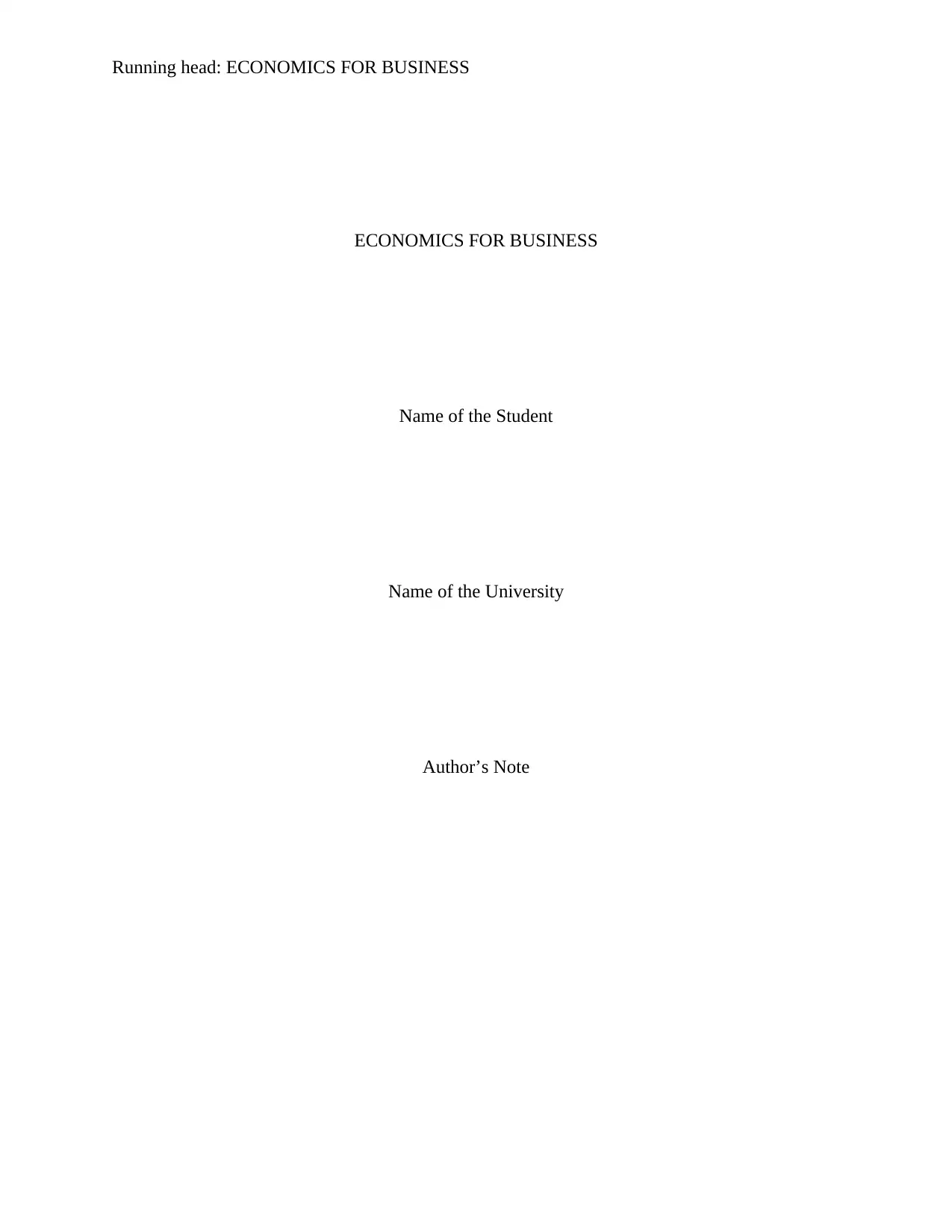
Running head: ECONOMICS FOR BUSINESS
ECONOMICS FOR BUSINESS
Name of the Student
Name of the University
Author’s Note
ECONOMICS FOR BUSINESS
Name of the Student
Name of the University
Author’s Note
Paraphrase This Document
Need a fresh take? Get an instant paraphrase of this document with our AI Paraphraser
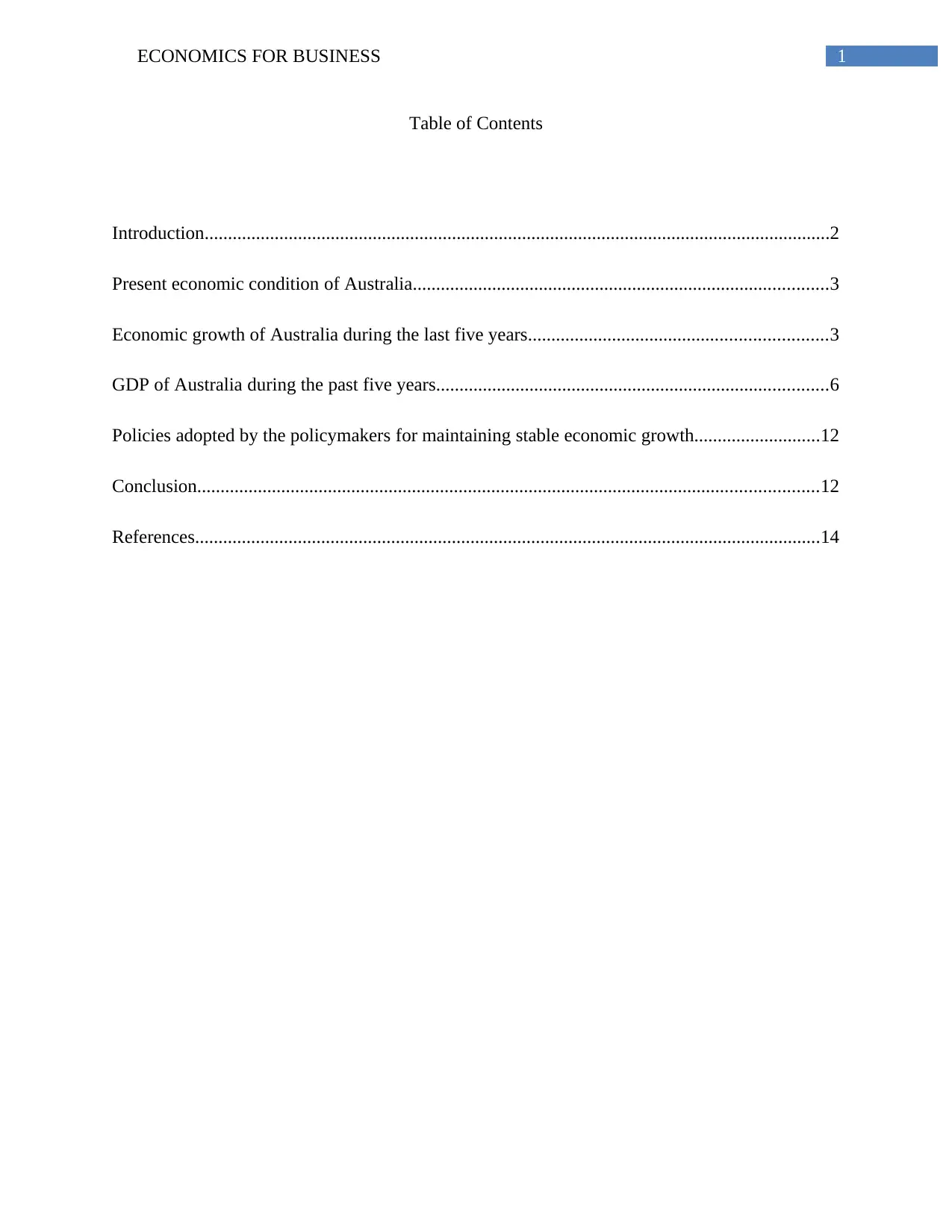
1ECONOMICS FOR BUSINESS
Table of Contents
Introduction......................................................................................................................................2
Present economic condition of Australia.........................................................................................3
Economic growth of Australia during the last five years................................................................3
GDP of Australia during the past five years....................................................................................6
Policies adopted by the policymakers for maintaining stable economic growth...........................12
Conclusion.....................................................................................................................................12
References......................................................................................................................................14
Table of Contents
Introduction......................................................................................................................................2
Present economic condition of Australia.........................................................................................3
Economic growth of Australia during the last five years................................................................3
GDP of Australia during the past five years....................................................................................6
Policies adopted by the policymakers for maintaining stable economic growth...........................12
Conclusion.....................................................................................................................................12
References......................................................................................................................................14

2ECONOMICS FOR BUSINESS
Introduction
The purpose of this report is to highlight on the economic growth and GDP (Gross
Domestic Product) of Australia over the last five years. Economic growth refers to an increase in
inflation adjusted value of products and services that is produced by a particular economy over
the years. It is usually measured as increase in real GDP that means rise in value of nation’s total
output. Economic growth is one of the crucial macroeconomic objectives as it enables rising
living standards, enhances in tax revenues and facilitates in creating jobs (Arena 2016). GDP in
Australia refers to the market value of all products and services produced within the geographical
boundary of Australia over the time. This macroeconomic indicators usually measures economic
performance of a specific country during a specific time period. The real GDP of Australia has
fluctuated considerably and ended at 2.3% in the year 2017. This fluctuation was mainly
contributed by consumer expenditure, government expenditure, investment expenditure and net
exports. At present, the economic growth of Australia has been increasing at its trend rate mainly
due to rise in consumer expenditure and government spending. Moreover, the standard of living
of Australians improved although there have been slight fluctuations in economic growth. The
non- mining sector of this nation specially contributed to economic growth of Australia along
with low unemployment rate and steady inflation rate. This report also analyzes on the present
economic condition of Australia based on growth of macroeconomic indicators including
unemployment rate, inflation rate and terms of trade. Furthermore, the policies adopted by the
Australian government for maintaining stable economic growth and GDP over the years are also
discussed in this report.
Introduction
The purpose of this report is to highlight on the economic growth and GDP (Gross
Domestic Product) of Australia over the last five years. Economic growth refers to an increase in
inflation adjusted value of products and services that is produced by a particular economy over
the years. It is usually measured as increase in real GDP that means rise in value of nation’s total
output. Economic growth is one of the crucial macroeconomic objectives as it enables rising
living standards, enhances in tax revenues and facilitates in creating jobs (Arena 2016). GDP in
Australia refers to the market value of all products and services produced within the geographical
boundary of Australia over the time. This macroeconomic indicators usually measures economic
performance of a specific country during a specific time period. The real GDP of Australia has
fluctuated considerably and ended at 2.3% in the year 2017. This fluctuation was mainly
contributed by consumer expenditure, government expenditure, investment expenditure and net
exports. At present, the economic growth of Australia has been increasing at its trend rate mainly
due to rise in consumer expenditure and government spending. Moreover, the standard of living
of Australians improved although there have been slight fluctuations in economic growth. The
non- mining sector of this nation specially contributed to economic growth of Australia along
with low unemployment rate and steady inflation rate. This report also analyzes on the present
economic condition of Australia based on growth of macroeconomic indicators including
unemployment rate, inflation rate and terms of trade. Furthermore, the policies adopted by the
Australian government for maintaining stable economic growth and GDP over the years are also
discussed in this report.
⊘ This is a preview!⊘
Do you want full access?
Subscribe today to unlock all pages.

Trusted by 1+ million students worldwide
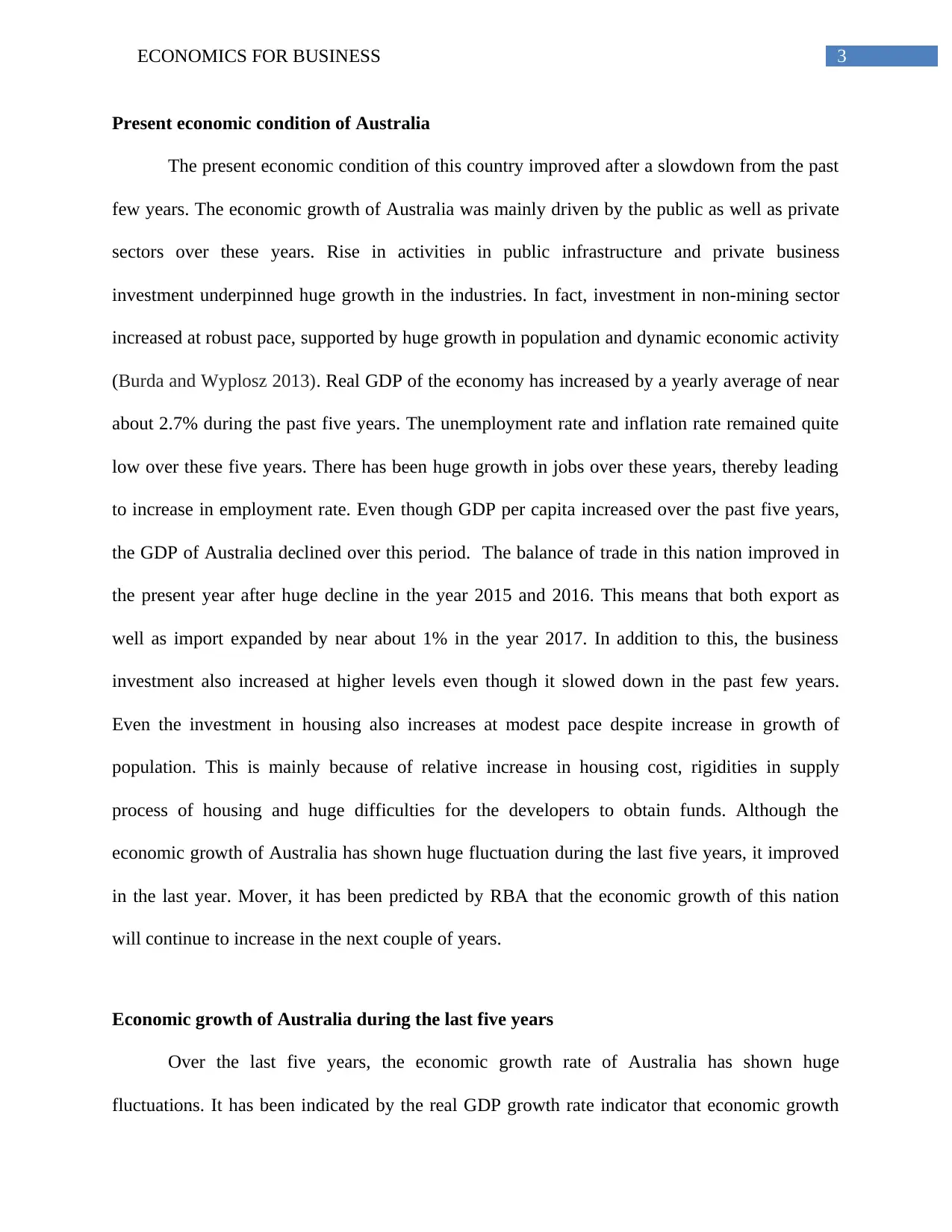
3ECONOMICS FOR BUSINESS
Present economic condition of Australia
The present economic condition of this country improved after a slowdown from the past
few years. The economic growth of Australia was mainly driven by the public as well as private
sectors over these years. Rise in activities in public infrastructure and private business
investment underpinned huge growth in the industries. In fact, investment in non-mining sector
increased at robust pace, supported by huge growth in population and dynamic economic activity
(Burda and Wyplosz 2013). Real GDP of the economy has increased by a yearly average of near
about 2.7% during the past five years. The unemployment rate and inflation rate remained quite
low over these five years. There has been huge growth in jobs over these years, thereby leading
to increase in employment rate. Even though GDP per capita increased over the past five years,
the GDP of Australia declined over this period. The balance of trade in this nation improved in
the present year after huge decline in the year 2015 and 2016. This means that both export as
well as import expanded by near about 1% in the year 2017. In addition to this, the business
investment also increased at higher levels even though it slowed down in the past few years.
Even the investment in housing also increases at modest pace despite increase in growth of
population. This is mainly because of relative increase in housing cost, rigidities in supply
process of housing and huge difficulties for the developers to obtain funds. Although the
economic growth of Australia has shown huge fluctuation during the last five years, it improved
in the last year. Mover, it has been predicted by RBA that the economic growth of this nation
will continue to increase in the next couple of years.
Economic growth of Australia during the last five years
Over the last five years, the economic growth rate of Australia has shown huge
fluctuations. It has been indicated by the real GDP growth rate indicator that economic growth
Present economic condition of Australia
The present economic condition of this country improved after a slowdown from the past
few years. The economic growth of Australia was mainly driven by the public as well as private
sectors over these years. Rise in activities in public infrastructure and private business
investment underpinned huge growth in the industries. In fact, investment in non-mining sector
increased at robust pace, supported by huge growth in population and dynamic economic activity
(Burda and Wyplosz 2013). Real GDP of the economy has increased by a yearly average of near
about 2.7% during the past five years. The unemployment rate and inflation rate remained quite
low over these five years. There has been huge growth in jobs over these years, thereby leading
to increase in employment rate. Even though GDP per capita increased over the past five years,
the GDP of Australia declined over this period. The balance of trade in this nation improved in
the present year after huge decline in the year 2015 and 2016. This means that both export as
well as import expanded by near about 1% in the year 2017. In addition to this, the business
investment also increased at higher levels even though it slowed down in the past few years.
Even the investment in housing also increases at modest pace despite increase in growth of
population. This is mainly because of relative increase in housing cost, rigidities in supply
process of housing and huge difficulties for the developers to obtain funds. Although the
economic growth of Australia has shown huge fluctuation during the last five years, it improved
in the last year. Mover, it has been predicted by RBA that the economic growth of this nation
will continue to increase in the next couple of years.
Economic growth of Australia during the last five years
Over the last five years, the economic growth rate of Australia has shown huge
fluctuations. It has been indicated by the real GDP growth rate indicator that economic growth
Paraphrase This Document
Need a fresh take? Get an instant paraphrase of this document with our AI Paraphraser
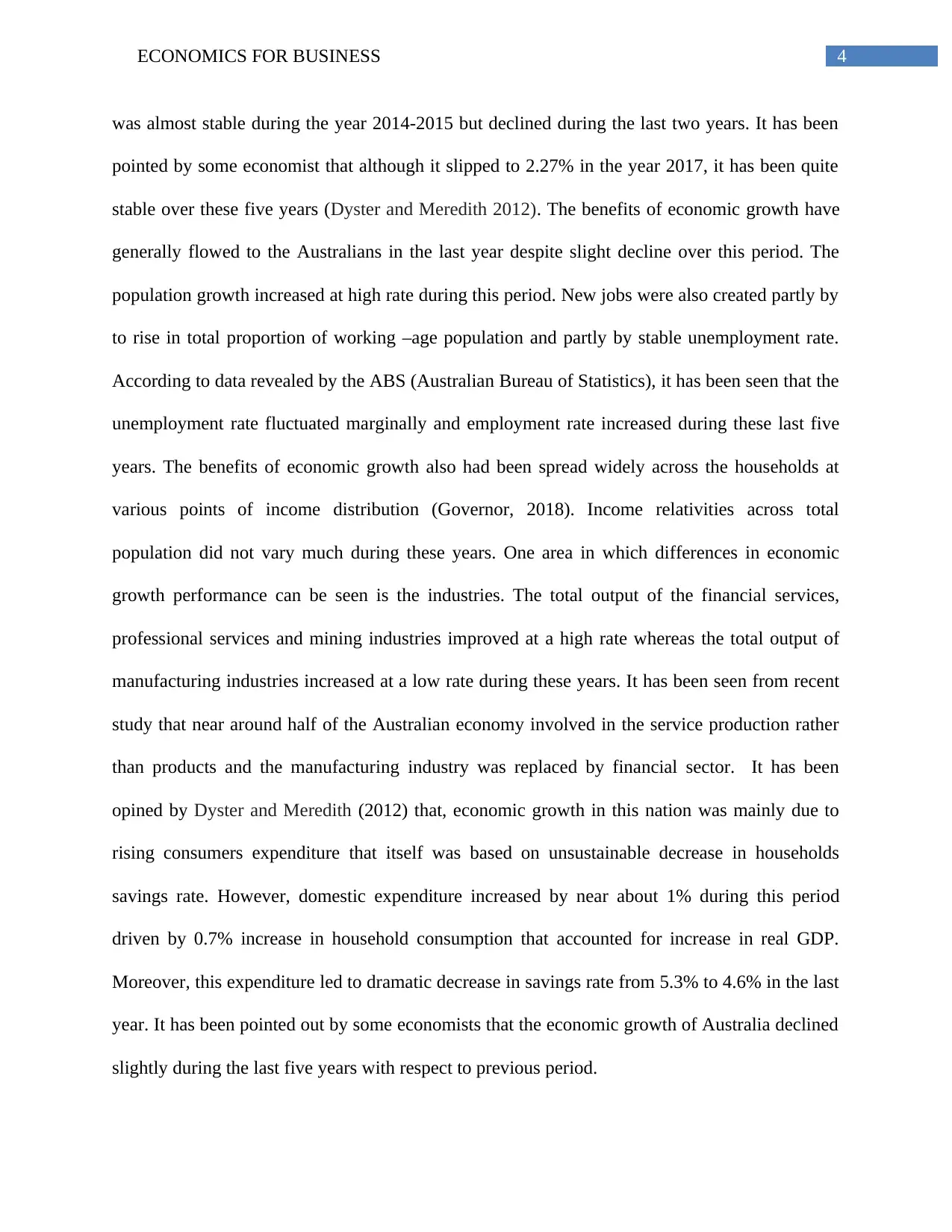
4ECONOMICS FOR BUSINESS
was almost stable during the year 2014-2015 but declined during the last two years. It has been
pointed by some economist that although it slipped to 2.27% in the year 2017, it has been quite
stable over these five years (Dyster and Meredith 2012). The benefits of economic growth have
generally flowed to the Australians in the last year despite slight decline over this period. The
population growth increased at high rate during this period. New jobs were also created partly by
to rise in total proportion of working –age population and partly by stable unemployment rate.
According to data revealed by the ABS (Australian Bureau of Statistics), it has been seen that the
unemployment rate fluctuated marginally and employment rate increased during these last five
years. The benefits of economic growth also had been spread widely across the households at
various points of income distribution (Governor, 2018). Income relativities across total
population did not vary much during these years. One area in which differences in economic
growth performance can be seen is the industries. The total output of the financial services,
professional services and mining industries improved at a high rate whereas the total output of
manufacturing industries increased at a low rate during these years. It has been seen from recent
study that near around half of the Australian economy involved in the service production rather
than products and the manufacturing industry was replaced by financial sector. It has been
opined by Dyster and Meredith (2012) that, economic growth in this nation was mainly due to
rising consumers expenditure that itself was based on unsustainable decrease in households
savings rate. However, domestic expenditure increased by near about 1% during this period
driven by 0.7% increase in household consumption that accounted for increase in real GDP.
Moreover, this expenditure led to dramatic decrease in savings rate from 5.3% to 4.6% in the last
year. It has been pointed out by some economists that the economic growth of Australia declined
slightly during the last five years with respect to previous period.
was almost stable during the year 2014-2015 but declined during the last two years. It has been
pointed by some economist that although it slipped to 2.27% in the year 2017, it has been quite
stable over these five years (Dyster and Meredith 2012). The benefits of economic growth have
generally flowed to the Australians in the last year despite slight decline over this period. The
population growth increased at high rate during this period. New jobs were also created partly by
to rise in total proportion of working –age population and partly by stable unemployment rate.
According to data revealed by the ABS (Australian Bureau of Statistics), it has been seen that the
unemployment rate fluctuated marginally and employment rate increased during these last five
years. The benefits of economic growth also had been spread widely across the households at
various points of income distribution (Governor, 2018). Income relativities across total
population did not vary much during these years. One area in which differences in economic
growth performance can be seen is the industries. The total output of the financial services,
professional services and mining industries improved at a high rate whereas the total output of
manufacturing industries increased at a low rate during these years. It has been seen from recent
study that near around half of the Australian economy involved in the service production rather
than products and the manufacturing industry was replaced by financial sector. It has been
opined by Dyster and Meredith (2012) that, economic growth in this nation was mainly due to
rising consumers expenditure that itself was based on unsustainable decrease in households
savings rate. However, domestic expenditure increased by near about 1% during this period
driven by 0.7% increase in household consumption that accounted for increase in real GDP.
Moreover, this expenditure led to dramatic decrease in savings rate from 5.3% to 4.6% in the last
year. It has been pointed out by some economists that the economic growth of Australia declined
slightly during the last five years with respect to previous period.
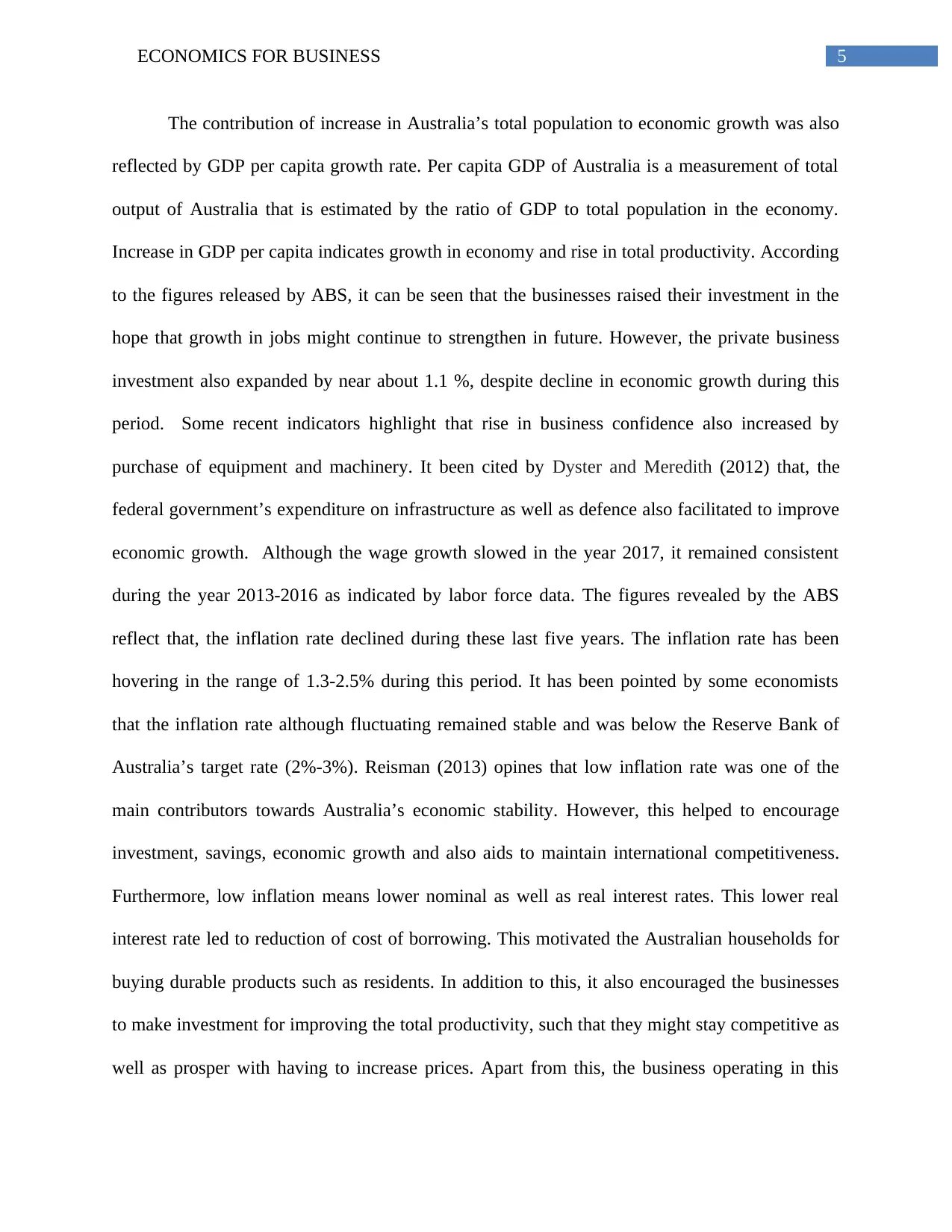
5ECONOMICS FOR BUSINESS
The contribution of increase in Australia’s total population to economic growth was also
reflected by GDP per capita growth rate. Per capita GDP of Australia is a measurement of total
output of Australia that is estimated by the ratio of GDP to total population in the economy.
Increase in GDP per capita indicates growth in economy and rise in total productivity. According
to the figures released by ABS, it can be seen that the businesses raised their investment in the
hope that growth in jobs might continue to strengthen in future. However, the private business
investment also expanded by near about 1.1 %, despite decline in economic growth during this
period. Some recent indicators highlight that rise in business confidence also increased by
purchase of equipment and machinery. It been cited by Dyster and Meredith (2012) that, the
federal government’s expenditure on infrastructure as well as defence also facilitated to improve
economic growth. Although the wage growth slowed in the year 2017, it remained consistent
during the year 2013-2016 as indicated by labor force data. The figures revealed by the ABS
reflect that, the inflation rate declined during these last five years. The inflation rate has been
hovering in the range of 1.3-2.5% during this period. It has been pointed by some economists
that the inflation rate although fluctuating remained stable and was below the Reserve Bank of
Australia’s target rate (2%-3%). Reisman (2013) opines that low inflation rate was one of the
main contributors towards Australia’s economic stability. However, this helped to encourage
investment, savings, economic growth and also aids to maintain international competitiveness.
Furthermore, low inflation means lower nominal as well as real interest rates. This lower real
interest rate led to reduction of cost of borrowing. This motivated the Australian households for
buying durable products such as residents. In addition to this, it also encouraged the businesses
to make investment for improving the total productivity, such that they might stay competitive as
well as prosper with having to increase prices. Apart from this, the business operating in this
The contribution of increase in Australia’s total population to economic growth was also
reflected by GDP per capita growth rate. Per capita GDP of Australia is a measurement of total
output of Australia that is estimated by the ratio of GDP to total population in the economy.
Increase in GDP per capita indicates growth in economy and rise in total productivity. According
to the figures released by ABS, it can be seen that the businesses raised their investment in the
hope that growth in jobs might continue to strengthen in future. However, the private business
investment also expanded by near about 1.1 %, despite decline in economic growth during this
period. Some recent indicators highlight that rise in business confidence also increased by
purchase of equipment and machinery. It been cited by Dyster and Meredith (2012) that, the
federal government’s expenditure on infrastructure as well as defence also facilitated to improve
economic growth. Although the wage growth slowed in the year 2017, it remained consistent
during the year 2013-2016 as indicated by labor force data. The figures revealed by the ABS
reflect that, the inflation rate declined during these last five years. The inflation rate has been
hovering in the range of 1.3-2.5% during this period. It has been pointed by some economists
that the inflation rate although fluctuating remained stable and was below the Reserve Bank of
Australia’s target rate (2%-3%). Reisman (2013) opines that low inflation rate was one of the
main contributors towards Australia’s economic stability. However, this helped to encourage
investment, savings, economic growth and also aids to maintain international competitiveness.
Furthermore, low inflation means lower nominal as well as real interest rates. This lower real
interest rate led to reduction of cost of borrowing. This motivated the Australian households for
buying durable products such as residents. In addition to this, it also encouraged the businesses
to make investment for improving the total productivity, such that they might stay competitive as
well as prosper with having to increase prices. Apart from this, the business operating in this
⊘ This is a preview!⊘
Do you want full access?
Subscribe today to unlock all pages.

Trusted by 1+ million students worldwide
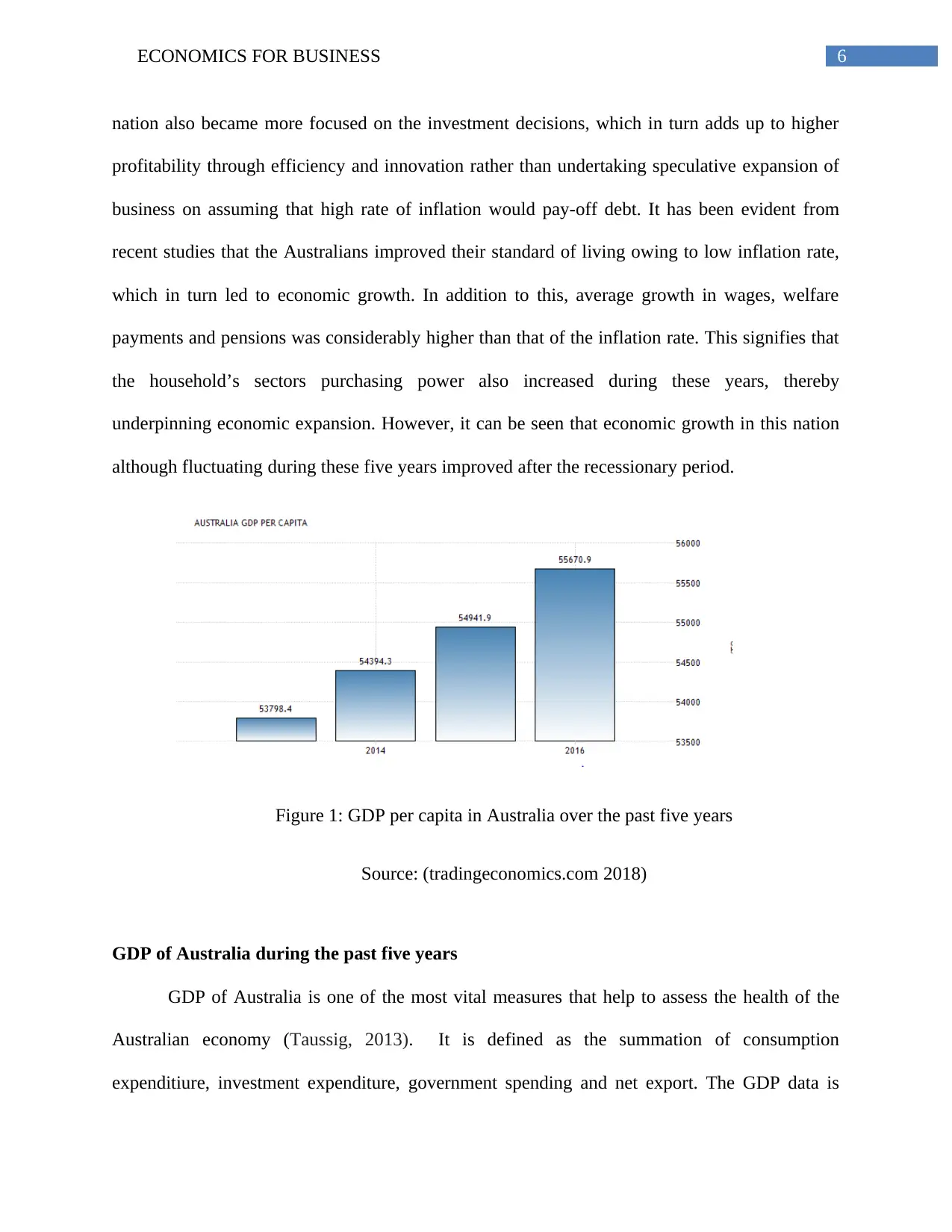
6ECONOMICS FOR BUSINESS
nation also became more focused on the investment decisions, which in turn adds up to higher
profitability through efficiency and innovation rather than undertaking speculative expansion of
business on assuming that high rate of inflation would pay-off debt. It has been evident from
recent studies that the Australians improved their standard of living owing to low inflation rate,
which in turn led to economic growth. In addition to this, average growth in wages, welfare
payments and pensions was considerably higher than that of the inflation rate. This signifies that
the household’s sectors purchasing power also increased during these years, thereby
underpinning economic expansion. However, it can be seen that economic growth in this nation
although fluctuating during these five years improved after the recessionary period.
Figure 1: GDP per capita in Australia over the past five years
Source: (tradingeconomics.com 2018)
GDP of Australia during the past five years
GDP of Australia is one of the most vital measures that help to assess the health of the
Australian economy (Taussig, 2013). It is defined as the summation of consumption
expenditiure, investment expenditure, government spending and net export. The GDP data is
nation also became more focused on the investment decisions, which in turn adds up to higher
profitability through efficiency and innovation rather than undertaking speculative expansion of
business on assuming that high rate of inflation would pay-off debt. It has been evident from
recent studies that the Australians improved their standard of living owing to low inflation rate,
which in turn led to economic growth. In addition to this, average growth in wages, welfare
payments and pensions was considerably higher than that of the inflation rate. This signifies that
the household’s sectors purchasing power also increased during these years, thereby
underpinning economic expansion. However, it can be seen that economic growth in this nation
although fluctuating during these five years improved after the recessionary period.
Figure 1: GDP per capita in Australia over the past five years
Source: (tradingeconomics.com 2018)
GDP of Australia during the past five years
GDP of Australia is one of the most vital measures that help to assess the health of the
Australian economy (Taussig, 2013). It is defined as the summation of consumption
expenditiure, investment expenditure, government spending and net export. The GDP data is
Paraphrase This Document
Need a fresh take? Get an instant paraphrase of this document with our AI Paraphraser
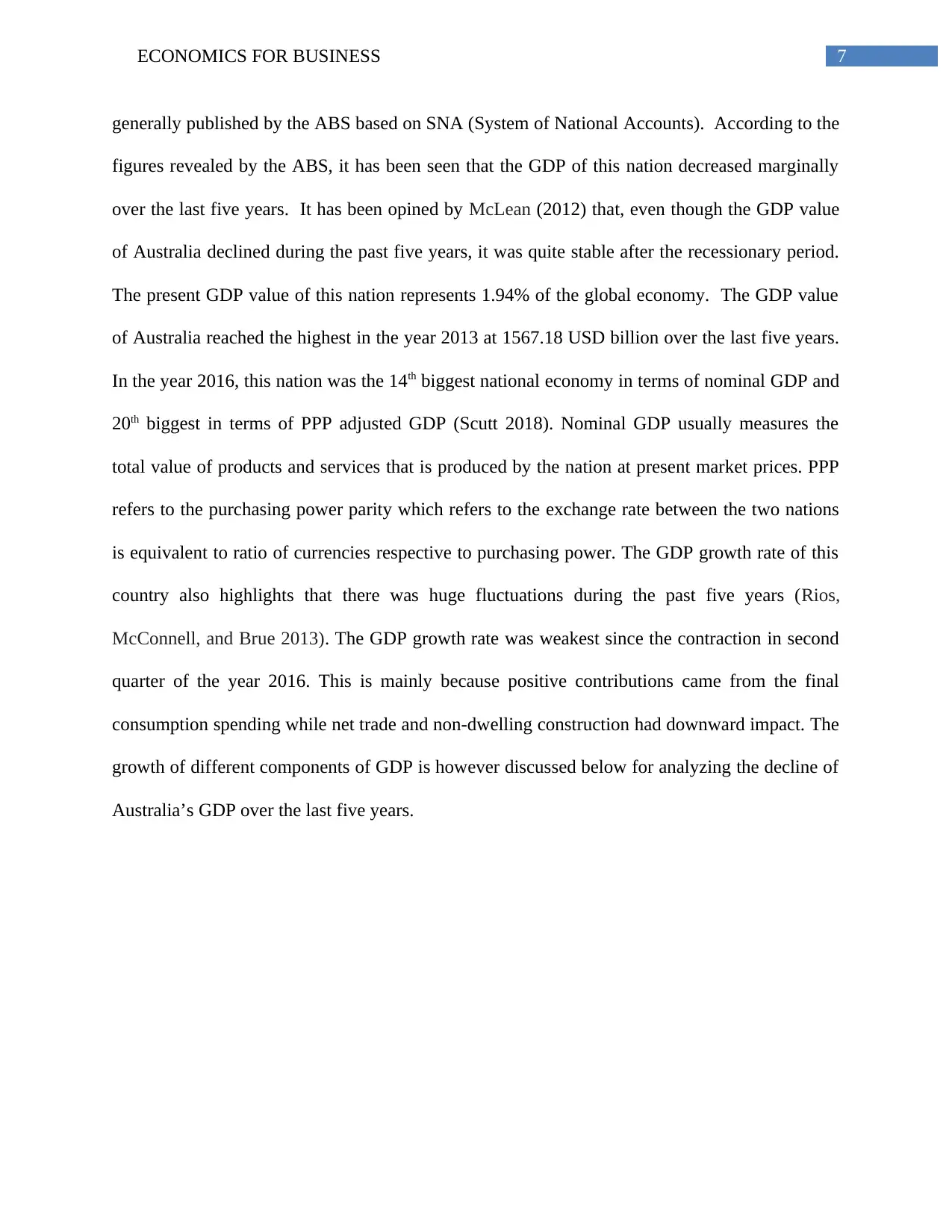
7ECONOMICS FOR BUSINESS
generally published by the ABS based on SNA (System of National Accounts). According to the
figures revealed by the ABS, it has been seen that the GDP of this nation decreased marginally
over the last five years. It has been opined by McLean (2012) that, even though the GDP value
of Australia declined during the past five years, it was quite stable after the recessionary period.
The present GDP value of this nation represents 1.94% of the global economy. The GDP value
of Australia reached the highest in the year 2013 at 1567.18 USD billion over the last five years.
In the year 2016, this nation was the 14th biggest national economy in terms of nominal GDP and
20th biggest in terms of PPP adjusted GDP (Scutt 2018). Nominal GDP usually measures the
total value of products and services that is produced by the nation at present market prices. PPP
refers to the purchasing power parity which refers to the exchange rate between the two nations
is equivalent to ratio of currencies respective to purchasing power. The GDP growth rate of this
country also highlights that there was huge fluctuations during the past five years (Rios,
McConnell, and Brue 2013). The GDP growth rate was weakest since the contraction in second
quarter of the year 2016. This is mainly because positive contributions came from the final
consumption spending while net trade and non-dwelling construction had downward impact. The
growth of different components of GDP is however discussed below for analyzing the decline of
Australia’s GDP over the last five years.
generally published by the ABS based on SNA (System of National Accounts). According to the
figures revealed by the ABS, it has been seen that the GDP of this nation decreased marginally
over the last five years. It has been opined by McLean (2012) that, even though the GDP value
of Australia declined during the past five years, it was quite stable after the recessionary period.
The present GDP value of this nation represents 1.94% of the global economy. The GDP value
of Australia reached the highest in the year 2013 at 1567.18 USD billion over the last five years.
In the year 2016, this nation was the 14th biggest national economy in terms of nominal GDP and
20th biggest in terms of PPP adjusted GDP (Scutt 2018). Nominal GDP usually measures the
total value of products and services that is produced by the nation at present market prices. PPP
refers to the purchasing power parity which refers to the exchange rate between the two nations
is equivalent to ratio of currencies respective to purchasing power. The GDP growth rate of this
country also highlights that there was huge fluctuations during the past five years (Rios,
McConnell, and Brue 2013). The GDP growth rate was weakest since the contraction in second
quarter of the year 2016. This is mainly because positive contributions came from the final
consumption spending while net trade and non-dwelling construction had downward impact. The
growth of different components of GDP is however discussed below for analyzing the decline of
Australia’s GDP over the last five years.
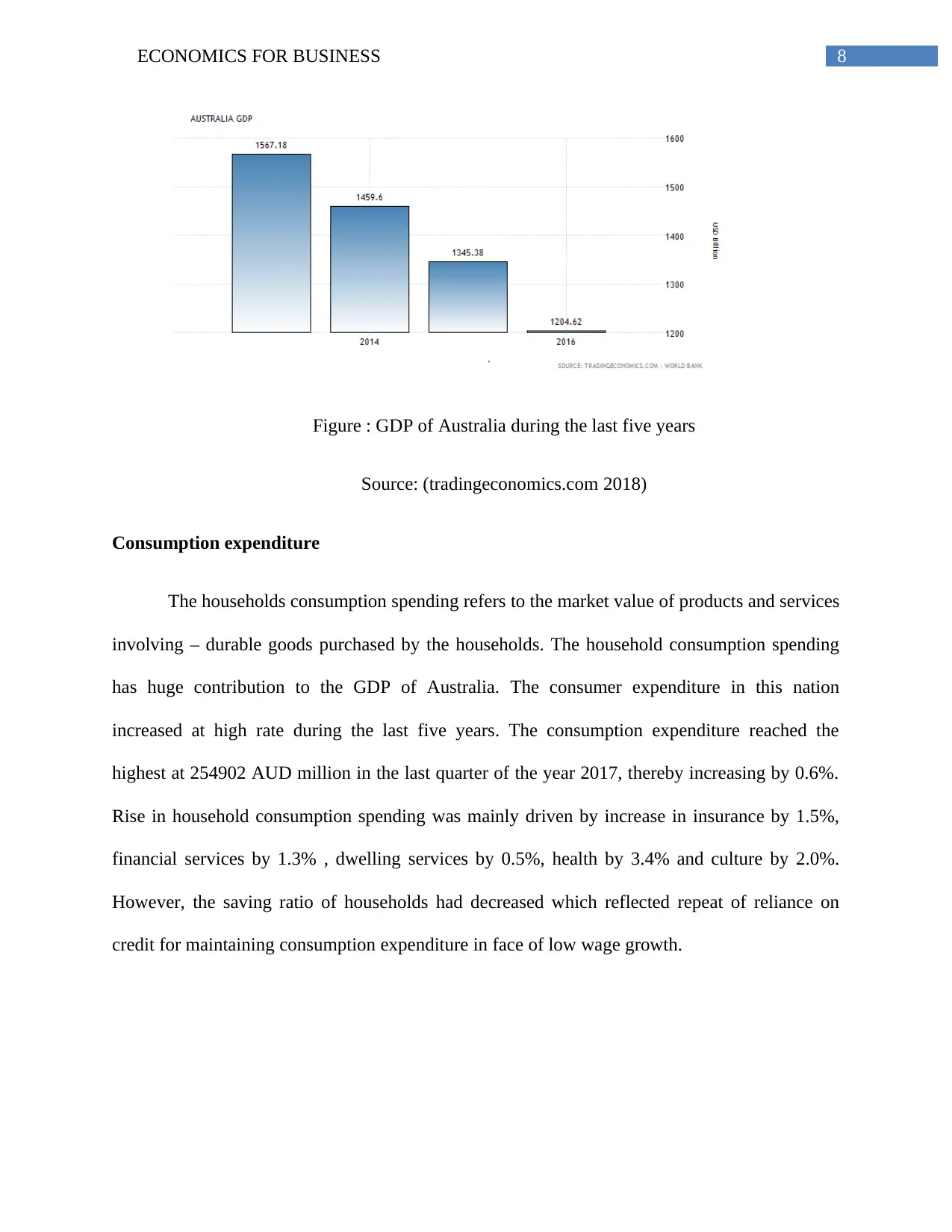
8ECONOMICS FOR BUSINESS
Figure : GDP of Australia during the last five years
Source: (tradingeconomics.com 2018)
Consumption expenditure
The households consumption spending refers to the market value of products and services
involving – durable goods purchased by the households. The household consumption spending
has huge contribution to the GDP of Australia. The consumer expenditure in this nation
increased at high rate during the last five years. The consumption expenditure reached the
highest at 254902 AUD million in the last quarter of the year 2017, thereby increasing by 0.6%.
Rise in household consumption spending was mainly driven by increase in insurance by 1.5%,
financial services by 1.3% , dwelling services by 0.5%, health by 3.4% and culture by 2.0%.
However, the saving ratio of households had decreased which reflected repeat of reliance on
credit for maintaining consumption expenditure in face of low wage growth.
Figure : GDP of Australia during the last five years
Source: (tradingeconomics.com 2018)
Consumption expenditure
The households consumption spending refers to the market value of products and services
involving – durable goods purchased by the households. The household consumption spending
has huge contribution to the GDP of Australia. The consumer expenditure in this nation
increased at high rate during the last five years. The consumption expenditure reached the
highest at 254902 AUD million in the last quarter of the year 2017, thereby increasing by 0.6%.
Rise in household consumption spending was mainly driven by increase in insurance by 1.5%,
financial services by 1.3% , dwelling services by 0.5%, health by 3.4% and culture by 2.0%.
However, the saving ratio of households had decreased which reflected repeat of reliance on
credit for maintaining consumption expenditure in face of low wage growth.
⊘ This is a preview!⊘
Do you want full access?
Subscribe today to unlock all pages.

Trusted by 1+ million students worldwide
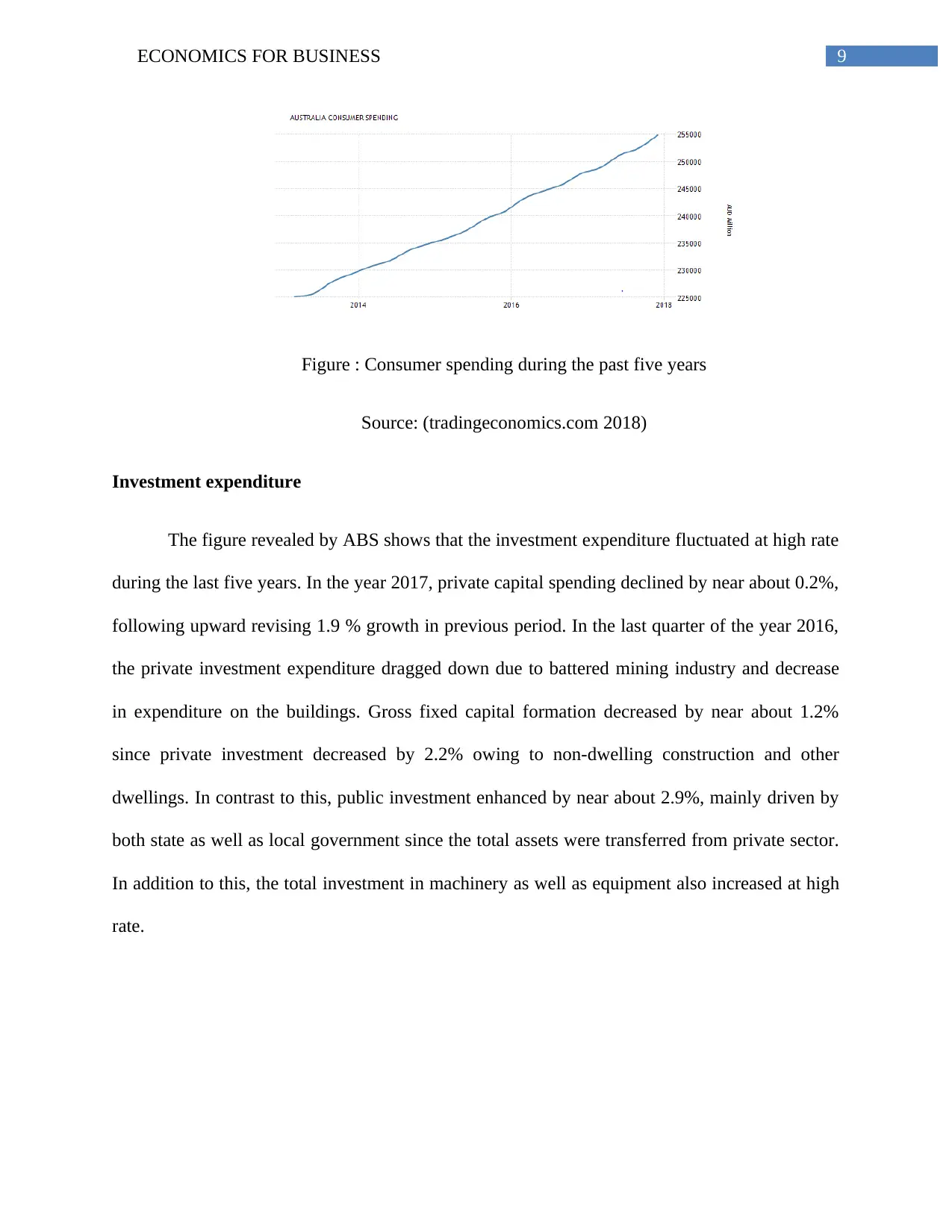
9ECONOMICS FOR BUSINESS
Figure : Consumer spending during the past five years
Source: (tradingeconomics.com 2018)
Investment expenditure
The figure revealed by ABS shows that the investment expenditure fluctuated at high rate
during the last five years. In the year 2017, private capital spending declined by near about 0.2%,
following upward revising 1.9 % growth in previous period. In the last quarter of the year 2016,
the private investment expenditure dragged down due to battered mining industry and decrease
in expenditure on the buildings. Gross fixed capital formation decreased by near about 1.2%
since private investment decreased by 2.2% owing to non-dwelling construction and other
dwellings. In contrast to this, public investment enhanced by near about 2.9%, mainly driven by
both state as well as local government since the total assets were transferred from private sector.
In addition to this, the total investment in machinery as well as equipment also increased at high
rate.
Figure : Consumer spending during the past five years
Source: (tradingeconomics.com 2018)
Investment expenditure
The figure revealed by ABS shows that the investment expenditure fluctuated at high rate
during the last five years. In the year 2017, private capital spending declined by near about 0.2%,
following upward revising 1.9 % growth in previous period. In the last quarter of the year 2016,
the private investment expenditure dragged down due to battered mining industry and decrease
in expenditure on the buildings. Gross fixed capital formation decreased by near about 1.2%
since private investment decreased by 2.2% owing to non-dwelling construction and other
dwellings. In contrast to this, public investment enhanced by near about 2.9%, mainly driven by
both state as well as local government since the total assets were transferred from private sector.
In addition to this, the total investment in machinery as well as equipment also increased at high
rate.
Paraphrase This Document
Need a fresh take? Get an instant paraphrase of this document with our AI Paraphraser
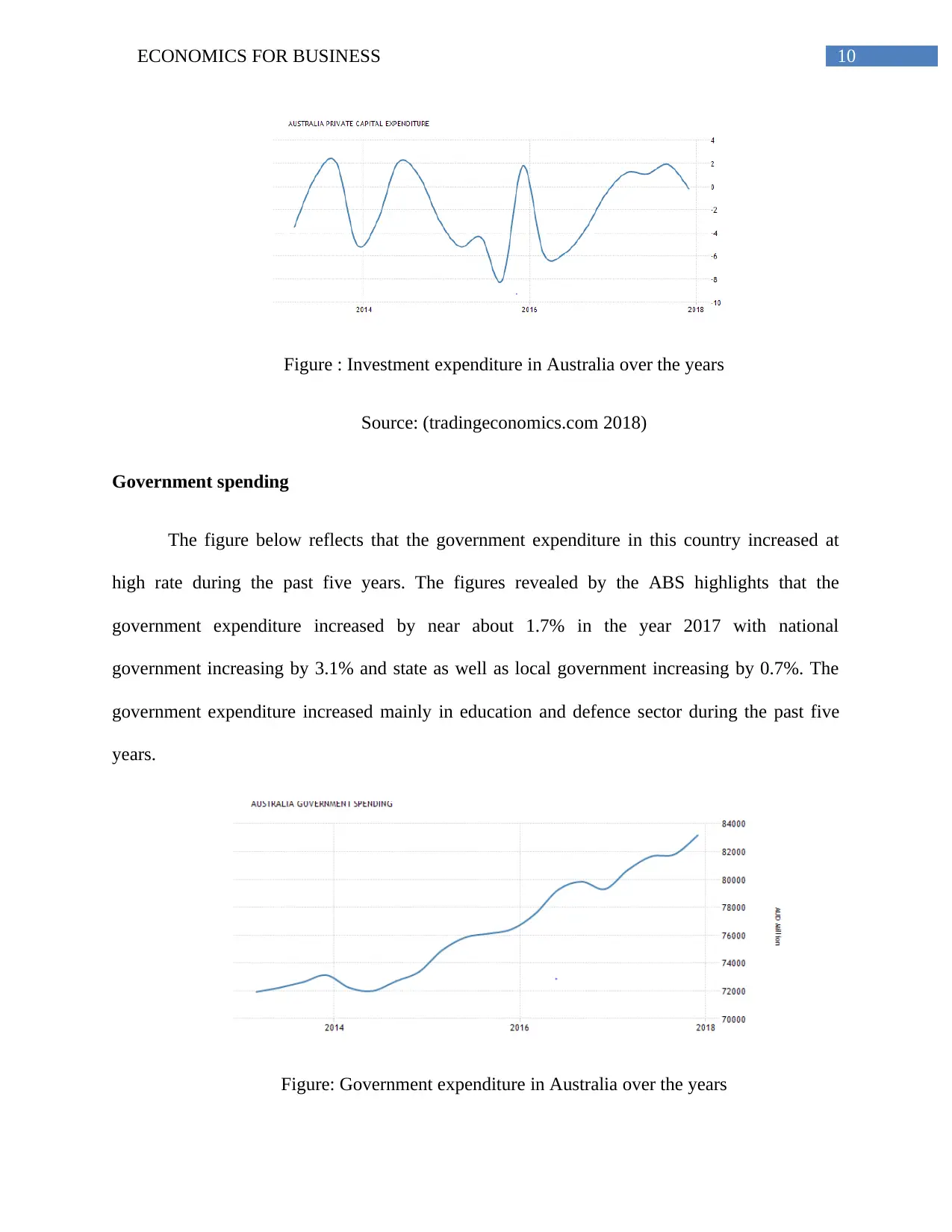
10ECONOMICS FOR BUSINESS
Figure : Investment expenditure in Australia over the years
Source: (tradingeconomics.com 2018)
Government spending
The figure below reflects that the government expenditure in this country increased at
high rate during the past five years. The figures revealed by the ABS highlights that the
government expenditure increased by near about 1.7% in the year 2017 with national
government increasing by 3.1% and state as well as local government increasing by 0.7%. The
government expenditure increased mainly in education and defence sector during the past five
years.
Figure: Government expenditure in Australia over the years
Figure : Investment expenditure in Australia over the years
Source: (tradingeconomics.com 2018)
Government spending
The figure below reflects that the government expenditure in this country increased at
high rate during the past five years. The figures revealed by the ABS highlights that the
government expenditure increased by near about 1.7% in the year 2017 with national
government increasing by 3.1% and state as well as local government increasing by 0.7%. The
government expenditure increased mainly in education and defence sector during the past five
years.
Figure: Government expenditure in Australia over the years
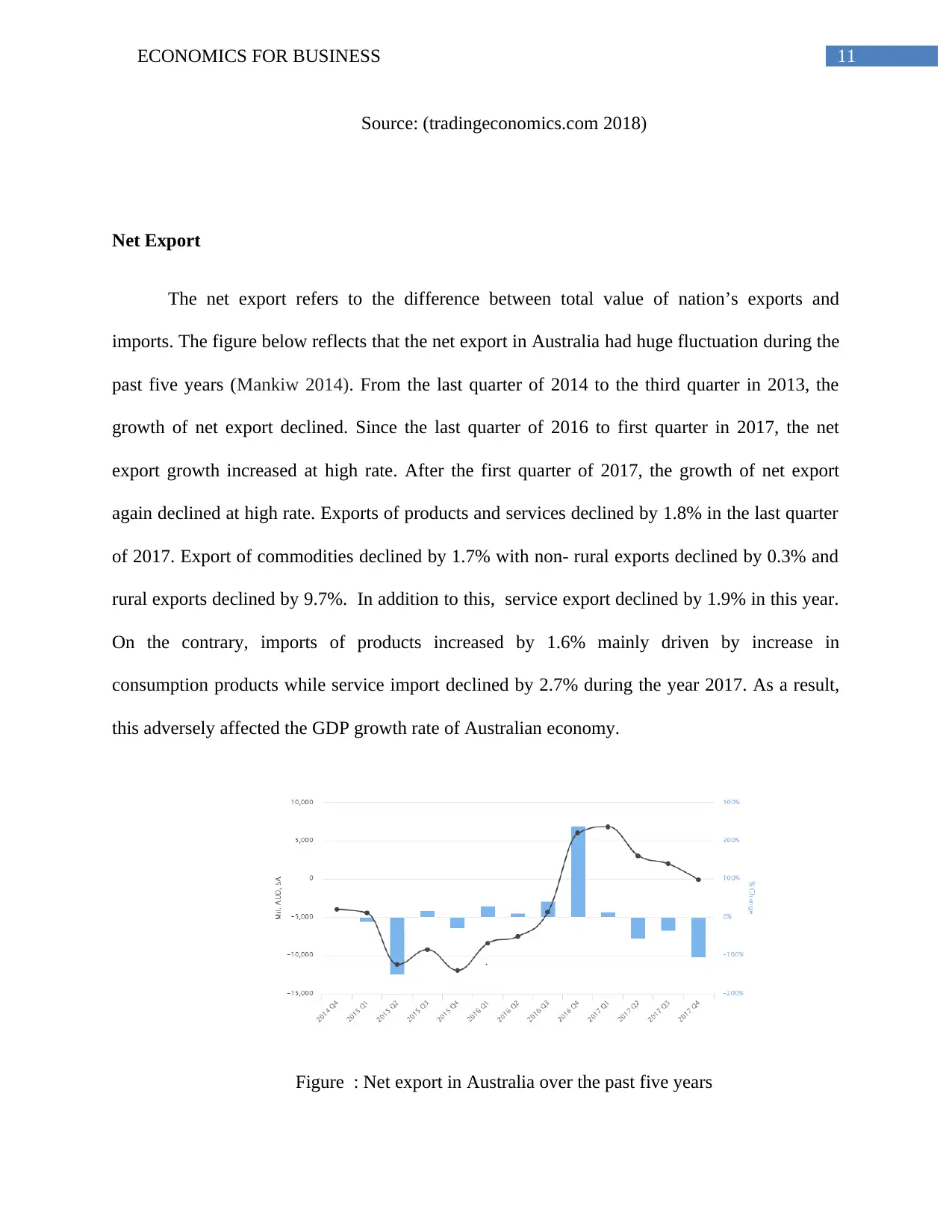
11ECONOMICS FOR BUSINESS
Source: (tradingeconomics.com 2018)
Net Export
The net export refers to the difference between total value of nation’s exports and
imports. The figure below reflects that the net export in Australia had huge fluctuation during the
past five years (Mankiw 2014). From the last quarter of 2014 to the third quarter in 2013, the
growth of net export declined. Since the last quarter of 2016 to first quarter in 2017, the net
export growth increased at high rate. After the first quarter of 2017, the growth of net export
again declined at high rate. Exports of products and services declined by 1.8% in the last quarter
of 2017. Export of commodities declined by 1.7% with non- rural exports declined by 0.3% and
rural exports declined by 9.7%. In addition to this, service export declined by 1.9% in this year.
On the contrary, imports of products increased by 1.6% mainly driven by increase in
consumption products while service import declined by 2.7% during the year 2017. As a result,
this adversely affected the GDP growth rate of Australian economy.
Figure : Net export in Australia over the past five years
Source: (tradingeconomics.com 2018)
Net Export
The net export refers to the difference between total value of nation’s exports and
imports. The figure below reflects that the net export in Australia had huge fluctuation during the
past five years (Mankiw 2014). From the last quarter of 2014 to the third quarter in 2013, the
growth of net export declined. Since the last quarter of 2016 to first quarter in 2017, the net
export growth increased at high rate. After the first quarter of 2017, the growth of net export
again declined at high rate. Exports of products and services declined by 1.8% in the last quarter
of 2017. Export of commodities declined by 1.7% with non- rural exports declined by 0.3% and
rural exports declined by 9.7%. In addition to this, service export declined by 1.9% in this year.
On the contrary, imports of products increased by 1.6% mainly driven by increase in
consumption products while service import declined by 2.7% during the year 2017. As a result,
this adversely affected the GDP growth rate of Australian economy.
Figure : Net export in Australia over the past five years
⊘ This is a preview!⊘
Do you want full access?
Subscribe today to unlock all pages.

Trusted by 1+ million students worldwide
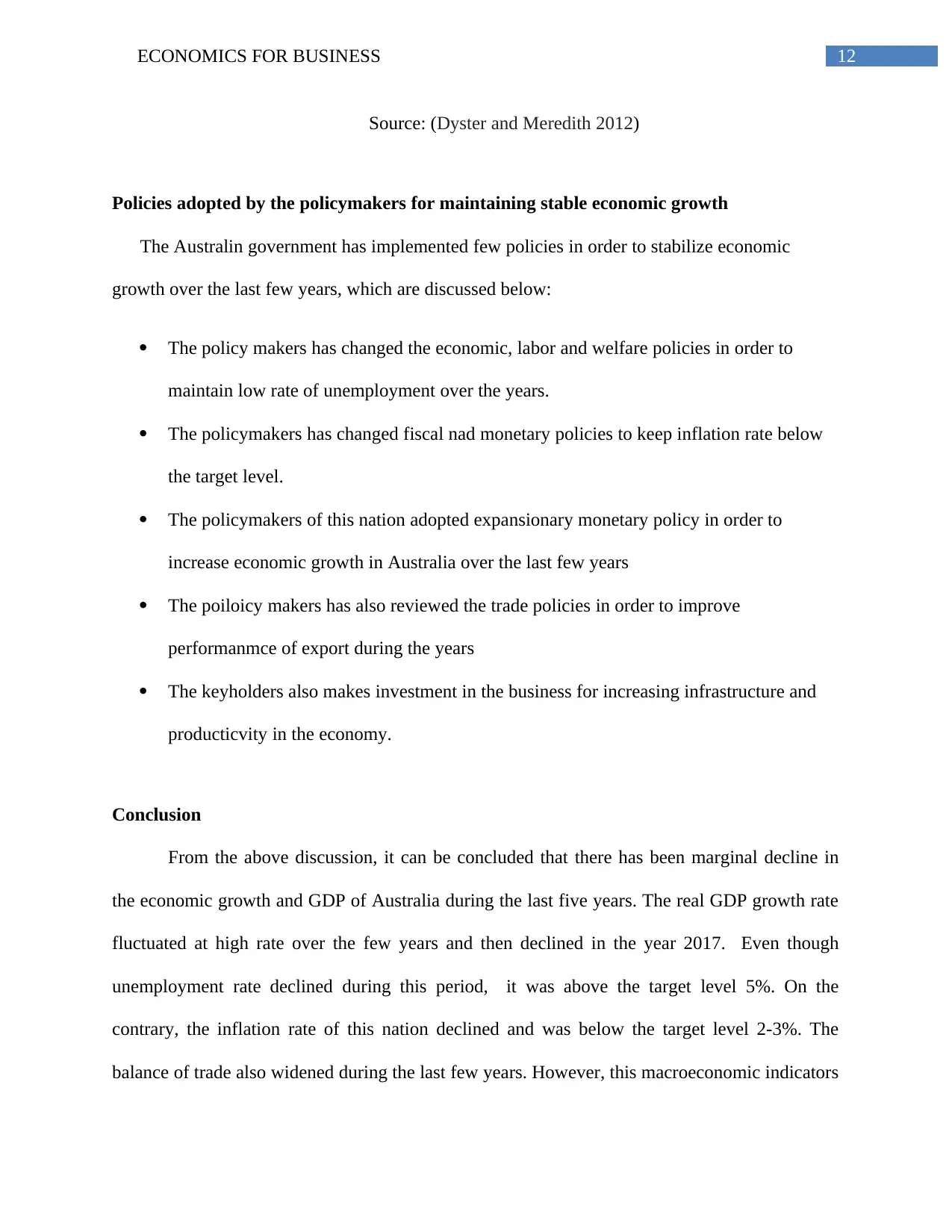
12ECONOMICS FOR BUSINESS
Source: (Dyster and Meredith 2012)
Policies adopted by the policymakers for maintaining stable economic growth
The Australin government has implemented few policies in order to stabilize economic
growth over the last few years, which are discussed below:
The policy makers has changed the economic, labor and welfare policies in order to
maintain low rate of unemployment over the years.
The policymakers has changed fiscal nad monetary policies to keep inflation rate below
the target level.
The policymakers of this nation adopted expansionary monetary policy in order to
increase economic growth in Australia over the last few years
The poiloicy makers has also reviewed the trade policies in order to improve
performanmce of export during the years
The keyholders also makes investment in the business for increasing infrastructure and
producticvity in the economy.
Conclusion
From the above discussion, it can be concluded that there has been marginal decline in
the economic growth and GDP of Australia during the last five years. The real GDP growth rate
fluctuated at high rate over the few years and then declined in the year 2017. Even though
unemployment rate declined during this period, it was above the target level 5%. On the
contrary, the inflation rate of this nation declined and was below the target level 2-3%. The
balance of trade also widened during the last few years. However, this macroeconomic indicators
Source: (Dyster and Meredith 2012)
Policies adopted by the policymakers for maintaining stable economic growth
The Australin government has implemented few policies in order to stabilize economic
growth over the last few years, which are discussed below:
The policy makers has changed the economic, labor and welfare policies in order to
maintain low rate of unemployment over the years.
The policymakers has changed fiscal nad monetary policies to keep inflation rate below
the target level.
The policymakers of this nation adopted expansionary monetary policy in order to
increase economic growth in Australia over the last few years
The poiloicy makers has also reviewed the trade policies in order to improve
performanmce of export during the years
The keyholders also makes investment in the business for increasing infrastructure and
producticvity in the economy.
Conclusion
From the above discussion, it can be concluded that there has been marginal decline in
the economic growth and GDP of Australia during the last five years. The real GDP growth rate
fluctuated at high rate over the few years and then declined in the year 2017. Even though
unemployment rate declined during this period, it was above the target level 5%. On the
contrary, the inflation rate of this nation declined and was below the target level 2-3%. The
balance of trade also widened during the last few years. However, this macroeconomic indicators
Paraphrase This Document
Need a fresh take? Get an instant paraphrase of this document with our AI Paraphraser
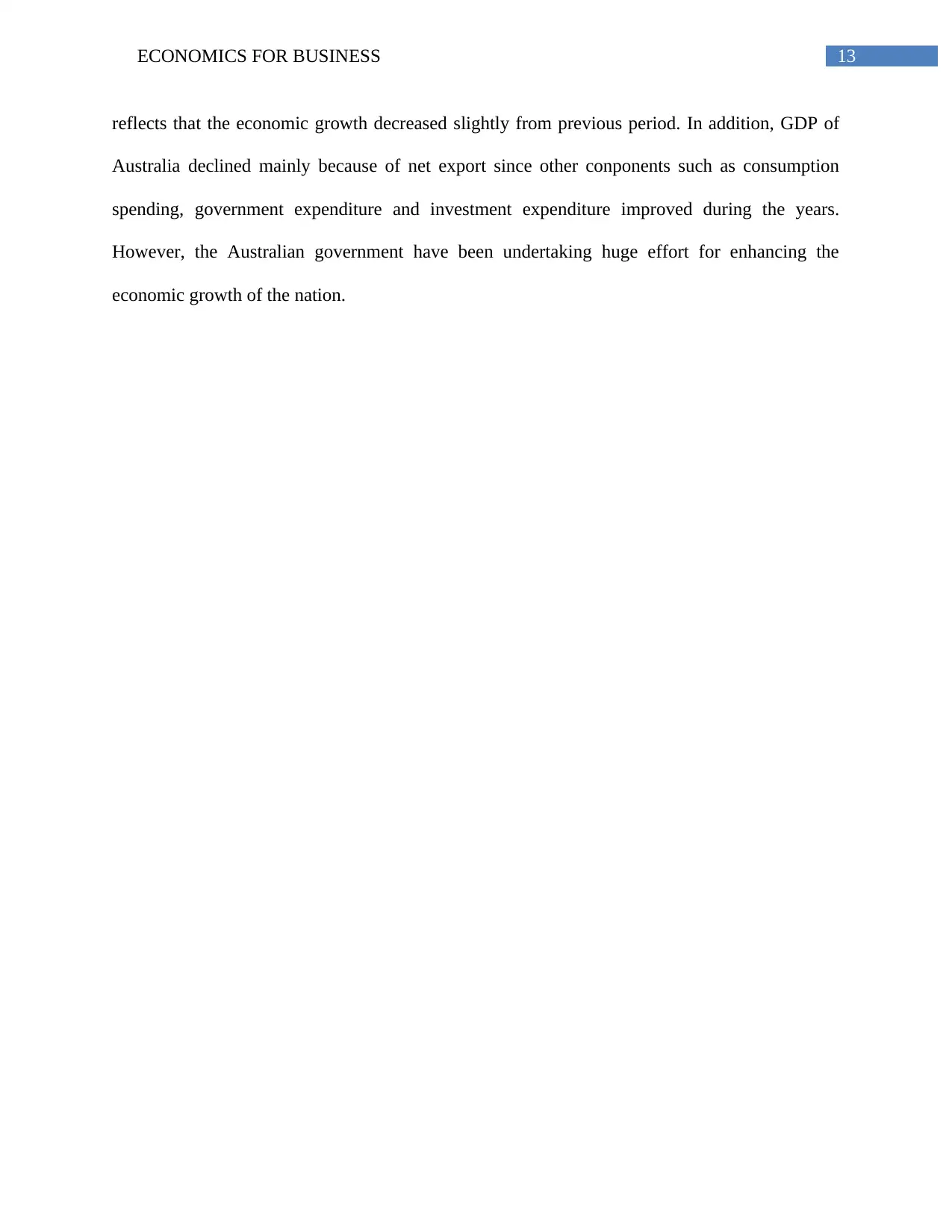
13ECONOMICS FOR BUSINESS
reflects that the economic growth decreased slightly from previous period. In addition, GDP of
Australia declined mainly because of net export since other conponents such as consumption
spending, government expenditure and investment expenditure improved during the years.
However, the Australian government have been undertaking huge effort for enhancing the
economic growth of the nation.
reflects that the economic growth decreased slightly from previous period. In addition, GDP of
Australia declined mainly because of net export since other conponents such as consumption
spending, government expenditure and investment expenditure improved during the years.
However, the Australian government have been undertaking huge effort for enhancing the
economic growth of the nation.

14ECONOMICS FOR BUSINESS
References
Arena, R., 2016. The economics of Alfred Marshall: revisiting Marshall's legacy. Springer.
Burda, M. and Wyplosz, C., 2013. Macroeconomics: a European text. Oxford university press.
Dyster, B. and Meredith, D., 2012. Australia in the global economy: continuity and change.
Cambridge University Press.
Governor, R. (2018). Twenty Years of Economic Growth | Speeches | RBA. [online] Reserve
Bank of Australia. Available at: https://www.rba.gov.au/speeches/2010/sp-dg-200810.html
[Accessed 19 May 2018].
Mankiw, N.G., 2014. Principles of macroeconomics. Cengage Learning.
McLean, I.W., 2012. Why Australia prospered: The shifting sources of economic growth.
Princeton University Press.
Reisman, D., 2013. The Economics of Alfred Marshall (Routledge Revivals). Routledge.
Rios, M.C., McConnell, C.R. and Brue, S.L., 2013. Economics: Principles, problems, and
policies. McGraw-Hill.
Scutt, D. (2018). GDP data confirms a decline in Australia's living standards and productivity.
[online] Business Insider Australia. Available at: https://www.businessinsider.com.au/australia-
economic-growth-q4-gdp-2018-3 [Accessed 19 May 2018].
Taussig, F.W., 2013. Principles of economics (Vol. 2). Cosimo, Inc..
References
Arena, R., 2016. The economics of Alfred Marshall: revisiting Marshall's legacy. Springer.
Burda, M. and Wyplosz, C., 2013. Macroeconomics: a European text. Oxford university press.
Dyster, B. and Meredith, D., 2012. Australia in the global economy: continuity and change.
Cambridge University Press.
Governor, R. (2018). Twenty Years of Economic Growth | Speeches | RBA. [online] Reserve
Bank of Australia. Available at: https://www.rba.gov.au/speeches/2010/sp-dg-200810.html
[Accessed 19 May 2018].
Mankiw, N.G., 2014. Principles of macroeconomics. Cengage Learning.
McLean, I.W., 2012. Why Australia prospered: The shifting sources of economic growth.
Princeton University Press.
Reisman, D., 2013. The Economics of Alfred Marshall (Routledge Revivals). Routledge.
Rios, M.C., McConnell, C.R. and Brue, S.L., 2013. Economics: Principles, problems, and
policies. McGraw-Hill.
Scutt, D. (2018). GDP data confirms a decline in Australia's living standards and productivity.
[online] Business Insider Australia. Available at: https://www.businessinsider.com.au/australia-
economic-growth-q4-gdp-2018-3 [Accessed 19 May 2018].
Taussig, F.W., 2013. Principles of economics (Vol. 2). Cosimo, Inc..
⊘ This is a preview!⊘
Do you want full access?
Subscribe today to unlock all pages.

Trusted by 1+ million students worldwide
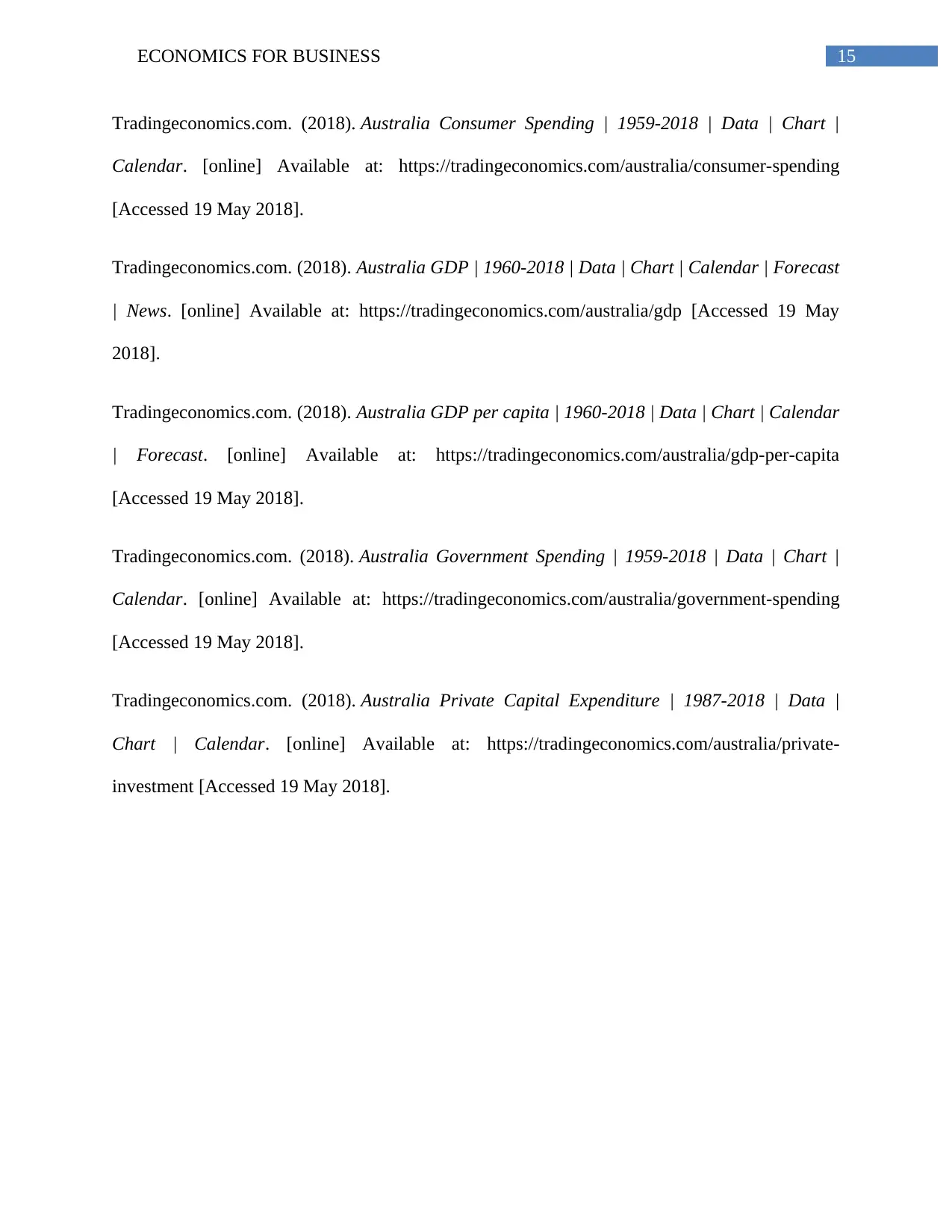
15ECONOMICS FOR BUSINESS
Tradingeconomics.com. (2018). Australia Consumer Spending | 1959-2018 | Data | Chart |
Calendar. [online] Available at: https://tradingeconomics.com/australia/consumer-spending
[Accessed 19 May 2018].
Tradingeconomics.com. (2018). Australia GDP | 1960-2018 | Data | Chart | Calendar | Forecast
| News. [online] Available at: https://tradingeconomics.com/australia/gdp [Accessed 19 May
2018].
Tradingeconomics.com. (2018). Australia GDP per capita | 1960-2018 | Data | Chart | Calendar
| Forecast. [online] Available at: https://tradingeconomics.com/australia/gdp-per-capita
[Accessed 19 May 2018].
Tradingeconomics.com. (2018). Australia Government Spending | 1959-2018 | Data | Chart |
Calendar. [online] Available at: https://tradingeconomics.com/australia/government-spending
[Accessed 19 May 2018].
Tradingeconomics.com. (2018). Australia Private Capital Expenditure | 1987-2018 | Data |
Chart | Calendar. [online] Available at: https://tradingeconomics.com/australia/private-
investment [Accessed 19 May 2018].
Tradingeconomics.com. (2018). Australia Consumer Spending | 1959-2018 | Data | Chart |
Calendar. [online] Available at: https://tradingeconomics.com/australia/consumer-spending
[Accessed 19 May 2018].
Tradingeconomics.com. (2018). Australia GDP | 1960-2018 | Data | Chart | Calendar | Forecast
| News. [online] Available at: https://tradingeconomics.com/australia/gdp [Accessed 19 May
2018].
Tradingeconomics.com. (2018). Australia GDP per capita | 1960-2018 | Data | Chart | Calendar
| Forecast. [online] Available at: https://tradingeconomics.com/australia/gdp-per-capita
[Accessed 19 May 2018].
Tradingeconomics.com. (2018). Australia Government Spending | 1959-2018 | Data | Chart |
Calendar. [online] Available at: https://tradingeconomics.com/australia/government-spending
[Accessed 19 May 2018].
Tradingeconomics.com. (2018). Australia Private Capital Expenditure | 1987-2018 | Data |
Chart | Calendar. [online] Available at: https://tradingeconomics.com/australia/private-
investment [Accessed 19 May 2018].
1 out of 16
Related Documents
Your All-in-One AI-Powered Toolkit for Academic Success.
+13062052269
info@desklib.com
Available 24*7 on WhatsApp / Email
![[object Object]](/_next/static/media/star-bottom.7253800d.svg)
Unlock your academic potential
© 2024 | Zucol Services PVT LTD | All rights reserved.



